With the NHL season just over two months away, it’s time to take a look at what the Boston Bruins’ roster will look like when the season rolls around on Oct. 3. Here’s we’ll dive into the Bruins’ defensive depth chart to preview what the blue line will look like next season.
I’ve broken the defensive corps down into three categories — “regulars,” who are locks on the blue line for next season, “bubble” players, who should get some time, but may not suit up for opening day, and of course, the “youngsters”, a group of prospects who will look to break into the NHL this season. Without further adieu, we present…
The Regulars
At the top of the defensive depth chart, there shouldn’t be much change, at least to start the season. Captain Zdeno Chara, who will enter his 15th NHL season, signed a one-year extension in March. While the Bruins have cut down on the aging Slovakian’s ice time over the past few seasons (he averaged 21:05 of ice last season, as compared to his 24:06 four seasons ago), they’ve given no indication that he’ll move off the top pairing.
Alongside Chara, Charlie McAvoy should be a regular on the top pair. The former Boston University Terrier, who has been widely labeled as the future No. 1 defenseman for the Bruins, has already begun taking over that role. McAvoy led Bruins skaters in ice time last season, averaging 22:10 per game, and once again demonstrated some promising progression on both sides of his game.
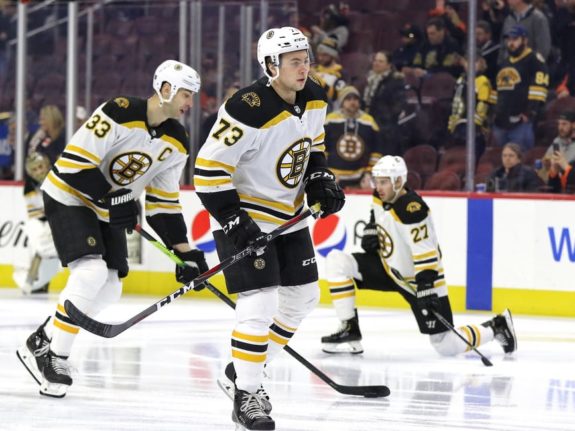
As of now, McAvoy remains unsigned for next season, but as a restricted free agent who is a centerpiece of the Bruins’ blueprint moving forward, there’s no question about whether McAvoy will be signed. Instead, discussions surrounding McAvoy’s future are focused on the terms of his upcoming contract.
While we’re on the topic of young defensemen who remain unsigned for next season, let’s talk Brandon Carlo. The 22-year-old is often overshadowed by his flashier, offensive-minded teammates, but Carlo has established himself over the past three seasons as a more-than-capable NHL defenseman who’s worth keeping around. Since breaking onto the NHL scene without missing a game in 2016-17, Carlo has built a sturdy, defense-first game that provides the Bruins with a rock on the back end.
Last season was the best of Carlo’s young career. He averaged the fourth-most ice-time among Bruins skaters, largely as a result of the lock-down defense that he’s proven himself capable of playing. Carlo also got his first taste of postseason play after missing the two prior postseasons with injuries and was a key piece of a defensive corps that led Boston to Game 7 of the Stanley Cup Final. Carlo, like McAvoy, will be a Bruin next season despite not being inked to a new contract yet. It’s just a matter of terms.
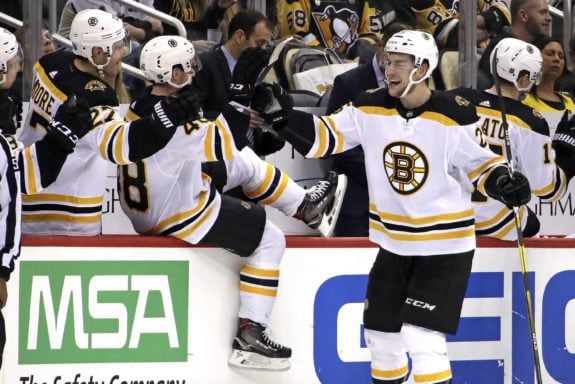
To round out the top four, we have Torey Krug, who has been a hot topic of discussion and debate. Krug, who is entering his age-28 season, is on the final year of his four-year, $21-million deal. He’s an unrestricted free agent after next season, and has expressed his desire to remain in Boston throughout his career. But Krug’s skillset and the Bruins’ current cap scenario make for a difficult arrangement.
Despite what some pro-trade advocates try to argue, Krug is a valuable asset to the team. He’s the power play quarter back and while the organization does have some youngsters with similar skillsets (McAvoy and Matt Grzelcyk are both dangerous options), nobody has seen as much success as Krug with the man advantage.
On top of that, Krug’s defensive game has improved over the last few seasons. While he’ll never be able to lock down the front of the net as well as Carlo, he can be trusted in his own end and can create mayhem for opposing teams when controlling the puck in the offensive zone.
Of course, Krug’s skillset is also the reason that he could be a valuable trade target. There are plenty of teams that would be happy to add a tested power-play quarterback who’s on the right side of thirty. Given the cap-shimmying that the Bruins are performing right now, it’s difficult to say with full confidence that they will be able to pay Krug the price tag he’s looking for next offseason. That being said, a Krug trade seems less likely as the summer rolls on. He has expressed genuine interest in staying in black an gold and, at least for now, I think he’ll remain there.
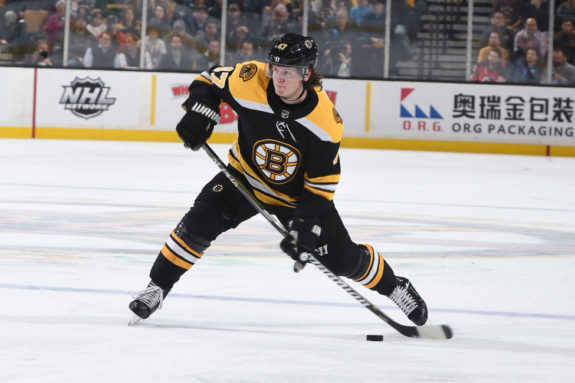
Finally, we have Grzelcyk, who closes out our list of “regulars” who are guaranteed a spot for next season. His performance since breaking onto the NHL scene has been extremely impressive. A former Boston University standout alongside McAvoy, the two broke into the NHL together at the end of the 2016-17 season. Grzelcyk was overshadowed by McAvoy in the early days, but last season especially, Grzelcyk proved that he’s much more than McAvoy’s terrier side-kick.
The 25-year-old was arguably Boston’s most consistent defender last season and promptly earned respect as an effective two-way blueliner. Offensively, Grzelcyk has excelled in safely moving the puck up the ice and has proven to be another option to run the point on the Bruins’ power-play.
On the back end, he’s hung around with the strongest of Boston’s defenders, displaying a willingness to adjust his game when necessary, but remaining a smart decision-maker through and through. Grzelcyk is someone that every B’s fan should keep an eye on next season, and if he does start on the third pairing, it’s only because the Bruins have a logjam of defensemen battling for ice time.
On the Bubble
Moving down the depth chart, things get a bit more interesting. As of now, the Bruins have a plethora of defensemen who will be battling it out for a roster spot when training camp rolls around.
Near the top of that list is Kevan Miller, the unapologetic, hard-nosed 31-year-old. The “Killer” was absent for a good portion of last season – he appeared in just 39 games due to injuries – but he provides a powerful physical presence that the Bruins could use. Miller, like Carlo, isn’t an offensively-gifted defender, but his defensive game has made strides when healthy, and he won’t hesitate to throw his 210-pound frame around with a vengeance. A healthy Miller should, at the very least, be a rotational player on the Bruins’ back end.
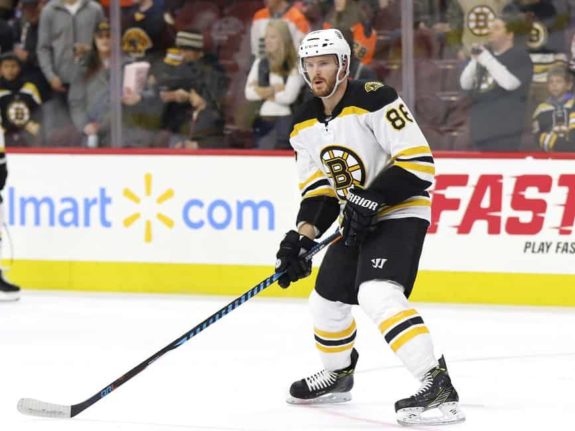
John Moore is another option to round out the defense. Moore did log the highest average ice-time of any defender not yet discussed above (he also had more than Miller), indicating that head coach Bruce Cassidy trusted the veteran with more ice than other depth options. That being said, he’s not a crucial piece of the team’s defensive corps, so he may not have priority when it comes to the final spot, especially when young players with potentially high upside are involved.
Next, we have Connor Clifton – aka “Cliffy Hockey” – who quickly became a fan-favorite in his limited time with Boston last season. Despite his lack of experience, Clifton looked pretty well put-together for a 23-year-old jumping head-first into the grind. Even with his sub-six-foot frame, the former Quinnipiac Bobcat plays a strong physical game and demonstrated waves of skill last season that should have Bruins fans excited.
Additionally, almost half of Clifton’s NHL experience has come in the postseason (18 of his 37 games), and he seemed to handle the pressure pretty well. I expect he’ll get an opportunity to continue proving himself at the NHL level this season, whether it’s right off the bat or not.

Another seemingly forgotten option is Steven Kampfer, the 30-year-old defender who has made a career bouncing around the NHL. He began his career in Boston during the 2010-11 season, and made his return this year, playing 35 regular-season games for the Bruins, as well as three in the postseason. Given the number of options on the back end, Kampfer will be the odd-man out at some point. That being said, he’s signed by the Bruins until the end of the 2021 season, and he could be a tested option to start the season.
The Youngsters
Last but not least, let’s take a look at some of the Bruins’ younger options. At the top of the hype list for defensive prospects we have Urho Vaakanainen. The 6-foot-1 Finnish defender was Boston’s first-round draft pick in 2017 (18th overall). He is a smart, heads-up player with offensive prowess who is effective at moving the puck up ice.
He spent most of last season with Providence, but faced injury trouble, finishing the season with 28 AHL games played (he did record 14 points). He also made a brief debut with the NHL squad, playing in two games before being injured on a vicious elbow from Ottawa Senator Mark Borowiecki.
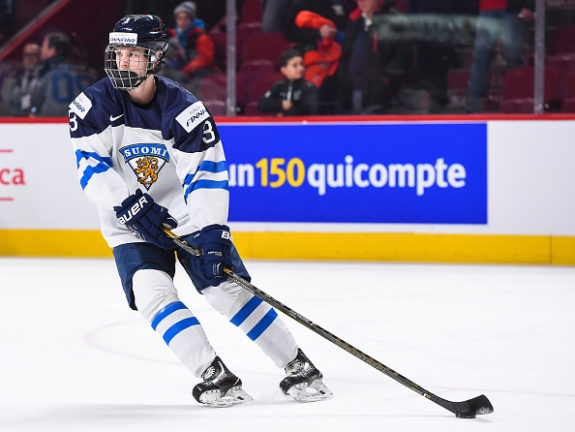
Vaakanainen also served as the alternate captain for the gold medal-winning Finland World Junior Championship team, averaging more than 23 minutes of ice per game, including a quarterfinal game against Canada in which he played 29:54.
He’s still very young (just 20 years old), and hasn’t been battle-tested quite yet, but many project him to be an effective starter in a few short years, so it’s likely he gets another look if all goes according to plan this season.
Jeremy Lauzon (drafted in 2015) is another prospect who could make an appearance at TD Garden this season. The 21-year-old played in 16 NHL games with the Bruins last season and buried his first NHL goal in November on an empty net after a dump in was tragically misplayed by Vegas Golden Knights goaltender Malcolm Subban. While that is Lauzon’s only NHL point to date, the young Quebec native showed some promise in his stint and should get another look this season.
Fellow 2015 draft pick Jakub Zboril also earned a brief NHL stint last season, appearing in two games with the Bruins’ varsity squad. Like Lauzon, Zboril will likely call Providence home for most of the season, but the Brno, Czech Republic native has made strides since being drafted and will likely earn another look this season.
That just about does it for our check-in on defensemen who could crack the lineup in the early stages of next season. Barring an unforeseen trade, the Bruins’ defensive unit will feature a combination of players listed above, reaching deeper into the pool as injuries and other circumstances present themselves.